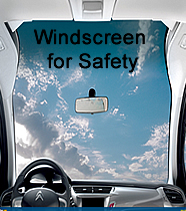 Windscreens Usages - In daily use, windscreens mainly protect the vehicle's occupants from wind, temperature extremes, and flying debris such as dust, insects, and rocks, as well as providing an aerodynamically formed window towards the front.
Windscreens Usages - In daily use, windscreens mainly protect the vehicle's occupants from wind, temperature extremes, and flying debris such as dust, insects, and rocks, as well as providing an aerodynamically formed window towards the front.
UV Coating may be applied to screen out harmful ultraviolet light. As the name implies, on motorbikes their main function is to shield the driver from the wind, though they do not do so as totally as those of a car, when the rider assumes the most aerodynamic optimal configuration of his or her body in unison with the machine and does not shield the rider from wind when sitting upright.
Windscreen for your Safety - Early windscreens were made of ordinary window glass, but that could lead to serious injuries in the event of a crash. A series of lawsuits led up to the development of stronger windscreens. The most notable example of this is the Pane vs. Ford case of 1917 that decided against Pane in that he was only injured through reckless driving. They were replaced with windscreens made of toughened glass and were fitted in the frame using a rubber or neoprene seal. The hardened glass shattered into many mostly harmless fragments when the windscreen broke. Windshields made using this process were actually two layers of glass with a cellulose inner layer. This inner layer held the glass together when it fractured. Modern, glued-in windscreens contribute to the vehicle's rigidity, but the main force for innovation has historically been the need to prevent injury from sharp glass fragments. Almost all nations now require windscreens to stay in one piece even if broken, except if pierced locally by a strong force. Properly installed automobile windscreens are also essential to safety; along with the roof of the car, they provide protection to the vehicle's occupants in the case of a roll-over accident.

